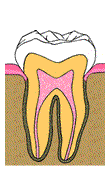What
is a Root Canal?
ROOT CANAL is a "lay
persons" term for endodontic therapy or root canal therapy. Root canal
therapy is necessary when the nerve inside the tooth becomes irreversibly
damaged or infected. This is usually due to the entry of bacteria into the
centermost part of the tooth called the dental pulp ("nerve").
Root canal therapy involves the removal of the entire nerve system, as well
as cleaning, shaping and filling 3-dimensionally the canal system with gutta-percha
and a dental sealer.
Is
a Root Canal for you?
Do you have any of
the following symptoms?
- Sensitivity to hot
or cold that lingers
- Discomfort when chewing
or biting
- Dull ache
- Discomfort that wakes
you up at night
- Your dentist has diagnosed
the need for endodontic treatment either by clinical exam or x-ray
If you answered yes
to any of the above, you might very well need a root canal.
Please call and schedule for an evaluation.
Be aware not all teeth
that ARE in need of root canal therapy will cause pain. It is possible to
be pain-free and still need a root canal.
What
is Involved in a Root Canal Procedure?
The endodontist examines
the x-ray and the tooth, then administers a local anesthetic. After the tooth
is numbed, a Small protective sheet, called a dental-dam is placed to isolate
the tooth, A Small opening will be made in the crown of the tooth and Small
instruments will be used to clean the canals and to shape the canal spaces
for filling. Once the canals have been adequately cleaned and shaped, the
canals will then be filled with a rubber-like material called "gutta-percha"
and sealer. A temporary filling is then placed to close the opening. Your
dentist will remove the temporary filling before the tooth is restored.
Is
the Root Canal Procedure Painful?
With modern techniques
and anesthetics the procedure is much faster and with less discomfort than
there has ever been. A similar anesthetic as the one used by your dentist
will be used for the root canal. For the first few days after treatment, your
tooth may feel sensitive to the bite. This discomfort can be relieved with
over-the-counter or prescription medications in order to control normal post-treatment
discomfort.
Will
I Feel Anything After Root Canal Treatment?
In most cases the quantity
and quality of discomfort will subside dramatically within the first 24-48
hours. Any sensitivity to cold, hot or even breathing air "in" will
be gone after your visit. Nevertheless, you may experience mild discomfort
that will last for several days after treatment. Taking over-the-counter medications
such as aspirin, Advil, Motrin, or Aleve usually relieves this discomfort.
Tylenol has been proven not to be as effective as aspirin, etc., because it
does not have the anti-inflammatory component as these other medications.
The most common complaint is tenderness to touch, bite, tapping or chewing
on the tooth. It is recommended to refrain from any of the above until your
dentist permanently restores your tooth.
What
are the Benefits of Root Canal Therapy Versus Extraction?
The single most important
benefit of root canal therapy is that you keep your tooth. Extraction may
lead to other dental problems. For instance, drifting of teeth, bite problems,
TMJ discomfort, and the need to treat adjacent teeth that do not otherwise
need dental treatment in order to restore the missing tooth. No matter how
effective modern tooth replacements are - and they can be very effective -
nothing is as good as your natural tooth.
Are Root Canals Making me Sick?
THE BOOK
In 1993, Dr. George Meinig published a book alleging that root-filled teeth
contribute to the incidence of systemic illness and "degenerative"
diseases. The book, Root Canal Cover-up Exposed! Many Illnesses Result,
based upon the focal infection research of Dr. Weston Price (c. 1910-1930),
states that bacteria trapped in dentin tubules during root canal treatments
can cause almost any type of "degenerative" disease, including rheumatic
fever, heart disease, kidney disease, arthritis, bladder disease, mental illness
and pregnancy complications, to name just a few. With this decades-old research
as his justification, Dr. Meinig recommends that concerned patients consider
extracting root-filled teeth. Dr. Meinig also alleges that Dr. Price's research
and his discovery of bacteria in the dentinal tubules have been "buried"
by self-interested dentists. Dr. Meinig is a founding member of the American
Association of Endodontists.
THE TRUTH
Attempts to replicate research indicating that root-filled teeth act as foci
of infection that contribute to systemic illness have been unsuccessful. Researchers
now believe the early correlations might be attributed to the crude sanitation
techniques and imprecise research protocols often practiced on cultures in
early bacteriology labs.1
Population studies performed
in the 1930s and 1940s failed to correlate the presence of illness to the
presence of root-filled teeth. Instead, researchers found that people with
root fillings were no more likely to be ill than people without them.1,2
Microbiologists have long
been aware of the presence of bacteria in the dentinal tubules. Certain strains
of bacteria are present in the mouth and teeth at all times, even in teeth
that have never had a cavity or other trauma. The mere presence of these bacteria
does not constitute "infection" and is not a threat to a person's
health.3
Dr. Price and the many
other researchers who explored the focal infection theory convinced us all
of the need to emphasize the importance of good oral health in maintaining
the overall health of our bodies. Their research brought up many valid questions
about how bacteria in our bodies affect our health, inspiring further research
on bacteria, the immune system and the safety and efficacy of root canal treatment.1-19 These studies support the truth we report today -- that properly root-filled
teeth do not cause systemic illness.
The members of the American
Association of Endodontists share Dr. Meinig's concern for the well being
of endodontically treated patients. Because we share that concern, however,
we cannot condone the recommendation to extract root-filled teeth for the
purpose of treating or preventing systemic illness. Saving the patient's natural
teeth, if at all possible, is always preferable to extraction.13 If artificial
teeth make a patient's bite feel unnatural the patient may avoid certain foods.
Maintaining the natural dentition is important so that the patient can continue
to enjoy the wide variety of foods necessary to maintain the proper nutrient
balance in his or her diet.
For most patients, the
natural tooth is preferable to a replacement and should be maintained whenever
possible. Endodontic treatment, along with restoration, is a cost effective
way to treat pulpally involved teeth and is usually less expensive than extraction
and placement of a bridge or implant.13 Endodontic treatment has
a very high success rate (over 90%), translating into countless millions of
healthy endodontically treated teeth serving patients all over the world.
Those healthy teeth are helping patients chew and bite efficiently, maintain
the natural appearance of their smile and enhance their enjoyment of life.
Through endodontic treatment, endodontists and dentists worldwide enable patients
to keep their natural teeth for a lifetime.
1Easlick K. An evaluation of the effect of dental foci of infection on health. JADA
1984;42:615-686, 694 -697.
2Grossman L. Pulpless teeth and focal infection. J Endodon 1982;8:S18-S24.
3Schonfeld SE. Oral microbial ecology. In: Slots J, Taubman M,
eds. Contemporary oral microbiology and immunology St. Louis: Mosby Year Book,
1992:267-274.
4Grossnman L. Root canal therapy. 4th ed. Philadelphia: Lea &
Febiger, 1955:15-40.
5Grossman L. Focal infection: Are oral foci of infection related
to systemic disease? Dent Clin N Amer 1960:749-63
6Bender IB, Seltzer S, Yermish M. The incidence of bacteremia in
endodontic manipulation. Oral Surg 1960;13(3):353-60
7Goldman M, Pearson A. A preliminary investigation of the "hollow-tube
theory" in endodontics: Studies with neo-tetrazolium. J Oral Therapeutics
and Pharm 1965; 1 (6):618-26.
8Torneck C. Reaction of rat connective tissue to polyethylene tube
implants. Part I. Oral Surg 1966;21 (3):379-87
9Torneck C. Reaction of rat connective tissue to polyethylene tube
implants. Part. II. Oral Surg 1967;24(5):674-83
10Phillips J. Rat connective tissue response to hollow polyethylene
tube implants. J Canad Dent Assoc 1967;33(2):59-64
11Davis M, Joseph S, Bucher J. Periapical and intracanal healing
following incomplete root canal fillings in dogs. Oral Surg 1971;31(5):662-675.
12Baumgarmer J, Heggers J, Harrison J. The incidence of bacteremias
related to endodontic procedures I. Nonsurgical endodontics. J Endodon 1976;2(5):135-40.
13Ehrmann E. Focal infection: The endodontic point of view. Oral
Surg 1977;44:628-34.
14Wenger J, Tsaknis P, delRio C, Ayer W. The effects of partially
filled polyethylene tube intraosseous implants in rats. Oral Surg 1978;46:88-100.
15Delivanis P, Snowden R, Doyle R. Localization of blood-borne
bacteria in instrumented unfilled root canals. Oral Surg 1981;52(4):430-32.
16Torabinejad M, Theofilopoulos A, Ketering J, Bakland L. Quantitation
of circulating immune complexes, immunoglobulins G and M, and C3 complement
component in patients with large periapical lesions. Oral Surg 1983;55(2):
186-90
17Delivanis P, Fan V. The localization of blood-borne bacteria
in instrumented unfilled and overinstrumented canals. J Endodon 1984;10(11):521-24.
18Benatti O, Valdrighi L, Biral R, Pupo J. A histological study
of the effect of diameter enlargement of the apical portion of the root canal,
J Endodon 1985;11(10):428-34.
19Wu M, Moorer W, Wesselink P. Capacity of anaerobic bacteria enclosed
in a simulated root canal to induce inflammation Internat Endodon J 22:269-77,
Nov./Dec. 1989.
|







